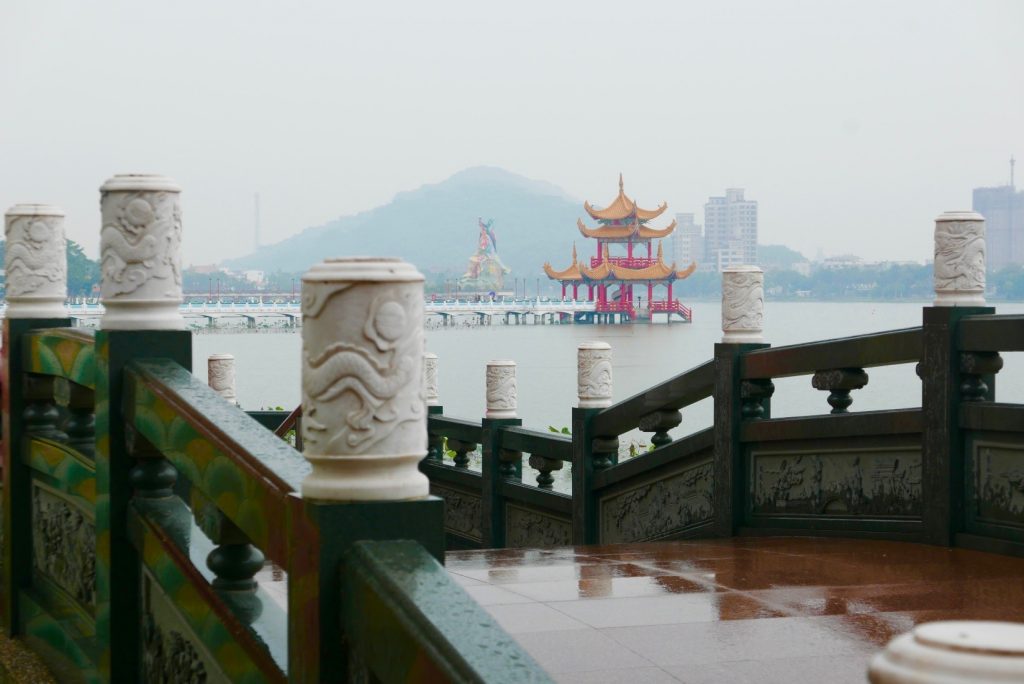It was over six years ago, but I still remember running around the various temples and ruins of Siem Reap. The joy of exploring and touching structures that date back centuries was such a thrill that even the smothering heat and humidity of the jungle did not bother me.

Fast forward to 2018 and I was again on a temple run but this time, my temple run focused on the area around Kaohsiung City’s famous Lotus Pond.
Located at Kaohsiung’s Zuoying District close to the Zuoying High Speed Rail Station, the Lotus Pond is actually a man-made lake as is a popular tourist attraction and is famous for the lotus plants that grow in the pond as well as its many temples and pagodas that surround the lake.
Although it was drizzling at the time I visited, it was a fun experience walking around the area enjoying the suburban vibe of Kaohsiung as well as breathing in some of Taiwan’s cultural heritage.
Here are some of the highlights which should not be missed when visiting the Lotus Pond.
Dragon and Tiger Pagodas
Rising seven stories high from the middle of the Lotus Pond the twin pagodas with their fronts adorned with a dragon and tiger with moths agape are probably the most famous landmarks in the area, has set up to stand on the lake. It is said that one should enter the pagoda through the dragon’s mouth and exit through the tiger’s month to change their bad fortune to good.
Across the Dragon and Tiger Pagodas is the Cih Ji Palace which was originally built in 1791 at Feng Shan but was eventually moved to Zuoying in 1960. It was the patrons of this temple who were responsible in building the Dragon and Tiger Pagodas.
Spring and Autumn Pavilions
Built in 1953, the Spring and Autumn Pavilions are located just a short walk from the Dragon and Tiger Pagodas. The pavilion features a giant dragon with the Chinese Goddess of Mercy perched atop it. Flanking the dragon are two four-storey Pavillions adorned with green tiles and yellow walls.
Beyond the twin pagodas one can walk along a causeway towards the Wuli Pavlion which floats in the middle of the pond.
Pei Chi Pavilion
Further north of the Spring and Autumn Pavilions is the Pei Chi Pavilion which honours the taoist deity Xuan Wu. Its biggest feature is its grand gate and a massive 72-meter statue of the deity himself rising from the waters of the Lotus Pond.
Confucius Temple
Although the farthest from most of the temples around the Lotus Pond, the Confucius Temple should not be missed.
Originally built in 1684, the old Confucius Temple has a circumference of122 meters. However, During the Japanese colonial period due to lack of maintenance, the only part of the original structure was the Chong Sheng Shrine, which is presently located in the west side of Old City Elementary School nearby Lotus Pond.
The new Confucius Temple built in 1977 is now located in northwest corner of Lotus Pond. Its design follows Song Dynasty designs andis where one can truly appreciate the intricate designs, patterns and colours of traditional Chinese architecture.
Although many of the temples surrounding the Lotus Pond don’t date back centuries and can, for some look kitsch, they do, however, give a glimpse to the wonderful world of traditional Chinese design, beliefs, lore, and religion.






